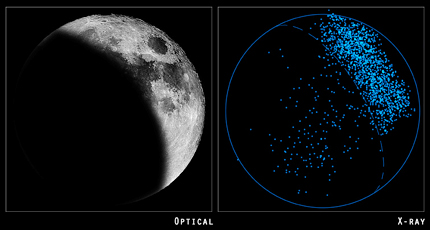September 16, 2003
CXC RELEASE: 03-09

Chandra Observation of The Moon
Press Image and Caption
Credit: Optical: Robert Gendler; X-ray: NASA/CXC/SAO/J.Drake et al.
Observations of the bright side of the Moon with NASA's Chandra X-ray Observatory have detected oxygen, magnesium, aluminum and silicon over a large area of the lunar surface. The abundance and distribution of those elements will help to determine how the Moon was formed.
"We see X-rays from these elements directly, independent of assumptions about the mineralogy and other complications," said Jeremy Drake of the Harvard-Smithsonian Center for Astrophysics in Cambridge, Mass., at a press conference at the "Four Years with Chandra" symposium in Huntsville, Alabama.
"We have Moon samples from the six widely-space Apollo landing sites, but remote sensing with Chandra can cover a much wider area," continued Drake. "It's the next best thing to being there, and it's very fast and cost-effective."
The lunar X-rays are caused by fluorescence, a process similar to the way that light is produced in fluorescent lamps. Solar X-rays bombard the surface of the Moon, knock electrons out of the inner parts of the atoms, putting them in a highly unstable state. Almost immediately, other electrons rush to fill the gaps, and in the process convert their energy into the fluorescent X-rays seen by Chandra.
According to the currently popular "giant impact" theory for the formation of the Moon, a body about the size of Mars collided with the Earth about 4.5 billion years ago. This impact flung molten debris from the mantle of both the Earth and the impactor into orbit around the Earth. Over the course of tens of millions of years, the debris stuck together to form the Moon. By measuring the amounts of aluminum and other elements over a wide area of the Moon and comparing them to the Earth's mantle, Drake and his colleagues plan to help test the giant impact hypothesis.
"One early result," quipped Drake, "is that there is no evidence for large amounts of calcium, so cheese is not a major constituent of the Moon."
The same Chandra data have also solved a long-running mystery about X-rays from the dark side of the Moon, as reported by Brad Wargelin of the Harvard-Smithsonian Center for Astrophysics. Wargelin discussed how data from the German Roentgen satellite (ROSAT) obtained in 1990 showed a clear X-ray signal from the dark side. These puzzling "dark-Moon X-rays" were tentatively ascribed to energetic electrons streaming away from the Sun and striking the lunar surface.
However, Chandra's observations of the energies of individual X-rays, combined with simultaneous measurements of the number of particles flowing away from the Sun in the solar wind, indicate that the X-rays only appear to come from the Moon. In reality they come from much closer to home.
"Our results strongly indicate that the so-called dark Moon X-rays do not come from the dark side of the Moon," said Wargelin. "The observed X-ray spectrum, the intensity of the X-rays, and the variation of the X-ray intensity with time, can all be explained by emission from Earth's extended outer atmosphere, through which Chandra is moving."
In the model cited by Wargelin and colleagues, collisions of heavy ions of carbon, oxygen and neon in the solar wind with atmospheric hydrogen atoms located tens of thousands of miles above the surface of the Earth give rise to these X-rays. In the collisions, the solar ions capture electrons from hydrogen atoms. The solar ions then kick out X-rays as the captured electrons drop to lower energy states.
"This idea has been kicking around among a small circle of believers for several years supported by theory and a few pieces of evidence," said Wargelin. "These new results should really clinch it."
NASA's Marshall Space Flight Center, Huntsville, Ala., manages the Chandra program for the Office of Space Science, NASA Headquarters, Washington. Northrop Grumman of Redondo Beach, Calif., formerly TRW, Inc., was the prime development contractor for the observatory. The Smithsonian Astrophysical Observatory controls science and flight operations from the Chandra X-ray Center in Cambridge, Mass.
MEDIA CONTACTS
Steve Roy
Marshall Space Flight Center, Huntsville, AL
Phone: 256-544-6535
Megan Watzke
Chandra X-ray Observatory Center, CFA, Cambridge, MA
Phone: 617-496-7998
cxcpress@cfa.harvard.edu



